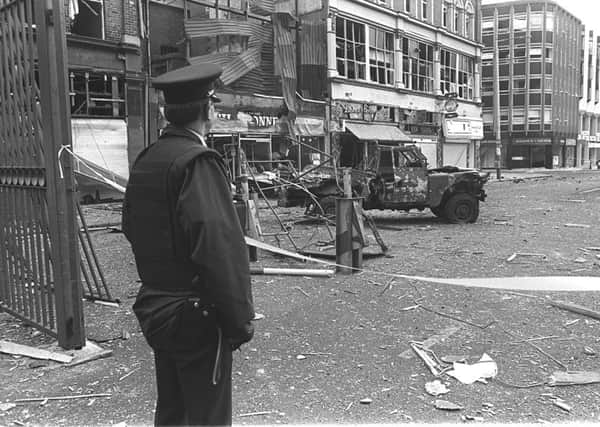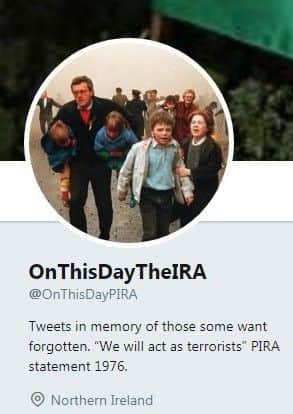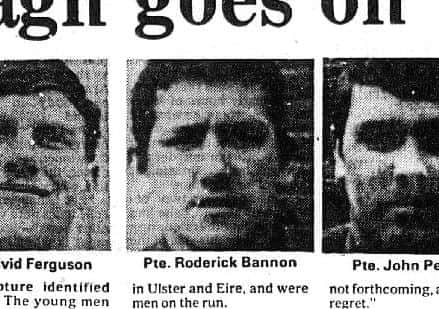Crimes of the IRA laid bare online to ‘combat twisted narrative’


For just over a year a Northern Ireland man has focused his efforts on posting daily reminders on social media about the human impact of the Provisional IRA’s campaign of terror.
The author of the Twitter account ‘On This Day The IRA’ wished to remain anonymous, although he was prepared to reveal that he is from a unionist background and grew up in the Province as the Troubles were coming to an end.
Advertisement
Hide AdAdvertisement
Hide AdFor the purposes of this article the acronym OTDTIRA will be used as his moniker as he explains the motivation behind setting up and maintaining his social media accounts which bring to light many lesser known IRA atrocities.
OTDTIRA, who also runs an associated Facebook page, said: “I started the account on January 17 last year. My motivation for doing that was a post I saw on Facebook. The post was about Teebane.”
The Teebane massacre took place on January 17, 1992. A roadside bomb at a rural crossroads between Omagh and Cookstown destroyed a van carrying 14 construction workers who had been repairing an Army base in Omagh. Eight men were killed and the rest were wounded. The IRA said the workers were killed because of their “collaboration” with the security forces.
OTDTIRA said: “Teebane is one of big ones that everyone is aware of, but I started wondering, there must be a lot of other murders carried out by the IRA that no one hears about.
Advertisement
Hide AdAdvertisement
Hide Ad“You always see posts about your Teebanes, Enniskillens, La Mons, but there are all sorts of individual incidents that are completely forgotten about. That was the spark that set it off.


“Initially the early tweets from the account I’m not happy with. Teebane was a single tweet which listed the names of the workmen and that was the height of it.
“I wasn’t happy with the level of detail. I’ve come full circle now and I’m going back over material I’ve done before. I won’t be happy with what I’ve done until I get back to March.
“Although I also have a Facebook page, I feel Twitter is the best medium for sharing this sort of information. I’m able to mix the material I can use. I can put up a video, photographs, newspaper reports in a thread.”
Advertisement
Hide AdAdvertisement
Hide AdIn an example of the prolificacy of the tweets from the OTDTIRA account, a few days ago on February 10 the deaths of six men were listed – all killed in separate incidents by the IRA in 1975, 1980 (2), 1981 and 1986 (2).


OTDTIRA, who was born in the eighties, said: “My memories of the Troubles are hazy. Most of the things I tweet about I’ve no experience of.
“Most of what I’m reporting is history.
“I set up the account to remember the victims of the IRA because there are powerful voices in Northern Ireland who would seek to justify the IRA’s actions.
“By posting simply what the IRA did I am trying to combat that twisted narrative.
Advertisement
Hide AdAdvertisement
Hide Ad“I have no time for terrorists of any kind, loyalists or any other republican groups whose deeds I have not included on my pages and in my blog.
“All murders were wrong and none can be justified.”
He added: “I suppose another reason for doing this is there’s lot of places where there will never be a physical memorial to anybody who was murdered because they took place in republican areas.”
He said that among the books he used for his research were Troubles’ chronology ‘Lost Lives’, Ken Wharton’s books on Operation Banner (the operational name for the Army’s operation in Northern Ireland from August 1969 to July 2007), Sam Trotter’s ‘Constabulary Heroes 1826 - 2009: Incorporating RUC GC / PSNI’, John Porter’s ‘Testimony of Courage: The History of the Ulster Defence Regiment’ and Gordon Gillespie’s ‘Troubles Remembered’.
OTDTIRA commented: “I have also been so grateful of the services of a researcher called Hannah. That’s not her real name. I genuinely don’t know who Hannah is and she doesn’t know who I am.
Advertisement
Hide AdAdvertisement
Hide Ad“She contacted me via the Facebook page to say she could help me look for material using microfilm. It is not an easy process.
“We would always be working a few months ahead. Her help has been so important.”
He said that in the past year he has been contacted via his social media pages by family members of victims featured ‘On This Day...’: “I get contacted by family members asking to have particular things posted, or information corrected from some sources. Sometimes it’s as simple as a name being spelt wrong.
“People send photographs asking that they be used instead of the ones that had been used previously. Sometimes that will be the only place where that photo has been available in public.”
Advertisement
Hide AdAdvertisement
Hide AdHaving maintained the site for more than a year, OTDTIRA is unsure how to proceed: “I don’t know what will happen now. I thought I would do it for a year, I didn’t even know if I’d get through the year. I suppose, what I want to do now is get to the end of March so that everything I’ve tweeted I’m relatively happy with. I think I’ve been fairly comprehensive with what I’ve covered.
“Once you have it done once properly it should be relatively easy to reproduce it and make it pop up again. You don’t have to do the research again.
“There’s the possibility of turning it into a book. There are a number of themes that come up which could be made into chapters – the hospital murders, the chapel murders, the murders of contractors.”
He added: “In my blog I use a quote from Joseph Stalin, ‘A single death is a tragedy, a million is a statistic’.
Advertisement
Hide AdAdvertisement
Hide Ad“Part of the problem with the IRA campaign is because so much time has passed and people have passed on, people can’t visualise the human impact. That’s why I tried to include as much information about the victims – that they were a married father of three children, they left a widow, etc.
“The act of putting photographs to each of the murders, where you can, humanises the person.
“It’s to try to get away from a statistic.
“That sort of thing is something that maybe the unionist community has been a bit reticent about.
“Inside unionism there has been an attitude of ‘yes, I suffered but I got on with it’.
Advertisement
Hide AdAdvertisement
Hide Ad“Whereas inside nationalism they have always appreciated the impact of a visual image. If you go down to a Bloody Sunday march they’d be there with pictures of the people who were shot.
“If you don’t have something visual, particularly in this age of Twitter when people are looking at things very briefly and don’t take it all in immediately, that sort of visual image has a bigger impact, it personalises it.”
In terms of statistics he said: “When you look at IRA murders it will show a certain per cent, a high percentage, were security force personnel, but what that doesn’t bring out is the percentage who were murdered when they were off duty.
“With the murder of UDR men their modus operandi was to shoot someone who was off duty doing their day job.
Advertisement
Hide AdAdvertisement
Hide Ad“I think people from my generation and younger generations might not appreciate that the UDR was a part time regiment, and that these people had a life in the community that wasn’t just a uniform.
“They gave up time with their family to patrol the roads, to try and bring security.”
Having got in contact with On This Day The IRA via Twitter, the son of a Scottish soldier who was murdered by the IRA in 1976 was able to see a picture of his father for the first time.
Conor Bannon had been nine months old when his father Roderick was one of three Scottish soldiers killed when a landmine was exploded under their vehicle.
Advertisement
Hide AdAdvertisement
Hide AdOTDTIRA said: “On March 31, 1976 three Scottish soldiers in the Royal Scots were blown up with a 300 pounds landmine at Beleeks in South Armagh. There’s never going to be any memorial to them down there. That’s why it’s important to remember them by whatever means possible.
“I tweeted about those murders on March 31 last year. Very recently, the son of Roderick Bannon tweeted in reply to that thread from last year to say, ‘that’s my dad’.
OTDTIRA explained: “I had found it difficult to find material on that particular incident.
“I messaged Conor privately to ask if he had a photo of his dad that I could share when I’m tweeting about it again this March. He told me that all the photos of his father had been destroyed or lost.
Advertisement
Hide AdAdvertisement
Hide Ad“He’d been nine months when that happened and had never seen a photograph of his father.
“I messaged my researcher Hannah who works with microfilm. I knew she was a number of months ahead of where we are now.
“She had got the front page of the News Letter which had a picture of all three soldiers who had been killed.
“I was able to show him a picture of his dad for the first time. He couldn’t believe it.”
Advertisement
Hide AdAdvertisement
Hide AdAnother touching story which OTDTIRA unearthed related to the IRA murder of five men on Brougher Mountain on February 6, 1971.
OTDTIRA said: “The IRA bombed a transmitter and planted a secondary device which was quite a common tactic. Five men went to repair it – one of them was with the BBC and four of them were contractors. The van they were in went over the trip wire and they were all blown up.
“The BBC man from England was David Henton. He was 24 years old. For many years his father would have come over and played a lament he wrote for his son on the mountain.”
Other murders which have been researched by OTDTIRA include the killings of three Co Fermanagh brothers who were members of the UDR in three separate incidents while off duty.
Advertisement
Hide AdAdvertisement
Hide AdRonald Graham was shot making coal deliveries to a house on June 5, 1981, Cecil died on November 11, 1981 after he was shot multiple times after visiting his wife who had just had a premature baby, and James was murdered when he was driving a schoolbus in Derrylin to take children swimming on February 1, 1985.
OTDTIRA added: “George Saunderson was a school teacher in Co Fermanagh who was shot 10 times in the back at his school (on April 10, 1974).
“That was how the IRA operated. I suppose the starkness of that is something that isn’t really brought out when people think of the Troubles.
“We tend to look at a bird’s eye view of it.”